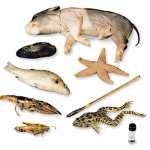Zoology
|
6 october 2015 15:51:43 |
| Influence of applying different units of measurement on reporting antimicrobial consumption data for pig farms (BMC Veterinary Research) |
|
Tweet Background:
Antimicrobial use in livestock is one of the factors contributing to selection and spread of resistant microorganisms in the environment. National veterinary antimicrobial consumption monitoring programs are therefore in place in a number of countries in the European Union. However, due to differences in methodology, results on veterinary antimicrobial consumption from these national monitoring programs cannot be compared internationally. International comparison is highly needed to establish regulations on veterinary antimicrobial use and reducing antimicrobial resistance. The aim of this study was to assess differences in the outcomes on veterinary antimicrobial consumption by applying three different sets of nationally established animal defined daily dosages to the same antimicrobial drug delivery dataset of Dutch pigs in 2012.
Methods:
Delivery information for the complete Dutch pig sector for the year 2012 reported to the Netherlands Veterinary Medicines Authority (SDa) was analysed with three differently and nationally established animal defined daily dosages from the Netherlands and Denmark: the Defined Daily Dosage Animal
NL
(DDDA
NL
), the Animal Daily Dosage
DK
(ADD
DK
) and Defined Animal Daily Dosage
DK
(DADD
DK
). For each applied Dutch product equivalent, Danish products were identified based on authorization for pigs, active substance (including form), administration route, concentration and dosage regimen.
Results:
Consumption in number of ADD
DK
/Y was lower than in number of DDDA
NL
/Y for sows/piglets and finisher pigs, with proportions of 83.3 % and 98.3 %. Use in number of DADD
DK
/Y was even lower, 79.7 % for sows/piglets and 88.1 % for finisher pigs compared to number of DDDA
NL
/Y. At therapeutic group level proportions of number of DADD
DK
/Y to number of DDDA
NL
/Y were 63.6-150.4 % (sows/piglets) and 55.6-171.0 % (finisher pigs). Proportions were > 100 % for the polymyxines (sows/piglets 150.4 % and finisher pigs 149.9 %) and the macrolides/lincosamides (finisher pigs 171.0 %).
Conclusions:
Differences between nationally established animal defined daily dosages caused by different correction factors for long-acting products and national differences in authorized dosages, have a substantial influence on the results of antimicrobial consumption in pigs. To enable international comparison of veterinary antimicrobial consumption data, harmonized units of measurement, animal weights and animal (sub) categories are needed. |
| 144 viewsCategory: Medicine, Zoology |
 Advances in the anatomic study of the interscapular region of the cat (BMC Veterinary Research) Advances in the anatomic study of the interscapular region of the cat (BMC Veterinary Research)Prospective study of the primary evaluation of 1016 horses with clinical signs of abdominal pain by veterinary practitioners, and the differentiation of critical and non-critical cases (Acta Veterinaria Scandinavica) 
|
| blog comments powered by Disqus |
MyJournals.org
The latest issues of all your favorite science journals on one page
The latest issues of all your favorite science journals on one page



